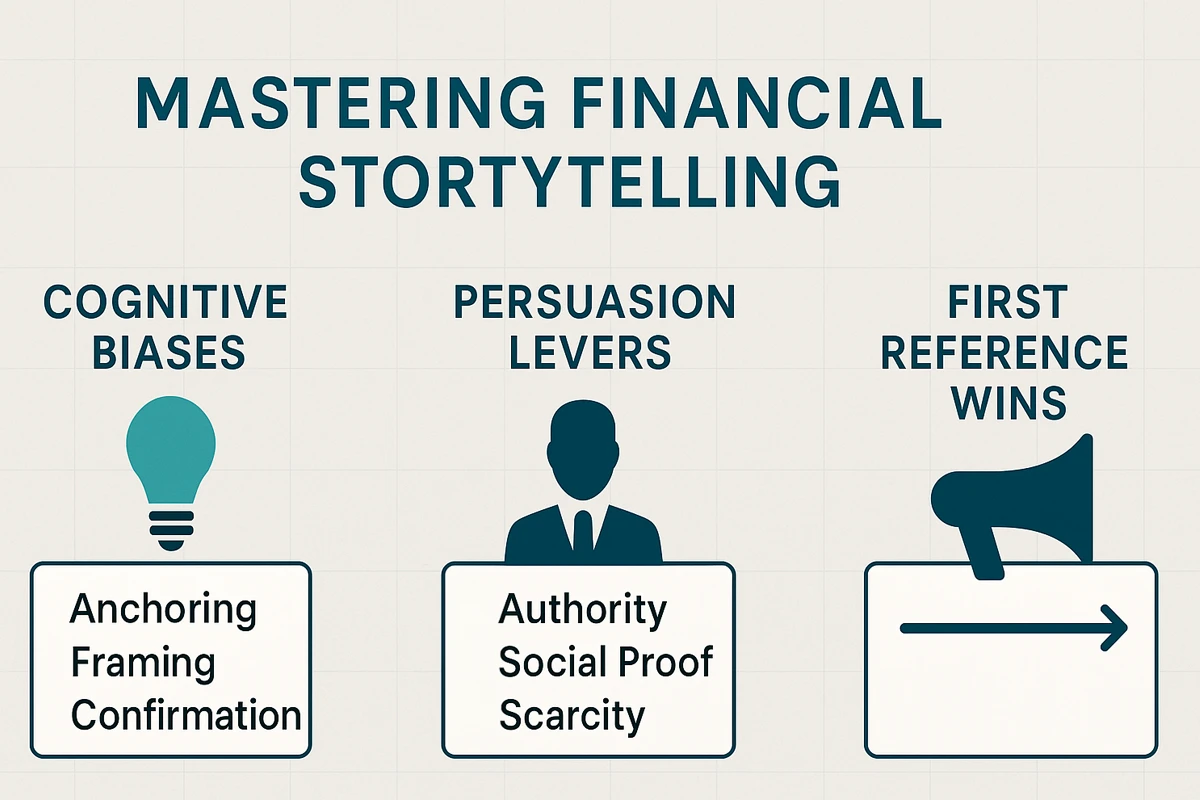Two nearly identical startups hit Series-A roadshows on the same week. Company A’s deck led with “We’re losing $1 million a month but growing fast.” Company B opened with “Each dollar we spend returns $3 in 18 months.” Same burn rate—wildly different reaction. Investors stampeded toward Company B, slashing their due-diligence time in half while Company A begged for meetings. The numbers never changed—only the story did. That’s the raw power of Law 16: Control the Financial Narrative. In the next few minutes you’ll learn how to frame your personal or business finances so lenders offer better terms, employers boost starting offers, and investors chase you—because once you command the story, you command the money.
What “Controlling the Financial Narrative” Really Means

Define It—Context Over Raw Numbers
Data without context is just noise. Controlling the narrative means you wrap every metric in a carefully chosen frame so outsiders see why it matters and how it serves your mission. Revenue down 8 %? Recast it as “strategic reinvestment” that positions you for a 30 % margin expansion next year. Personal example: instead of saying “I only saved $5 000,” say “I built a six-month emergency fund—now every extra dollar goes straight into high-growth index funds.”
Why Narrative Beats Data Alone
Humans make decisions emotionally first, rationally second. A spreadsheet says, “We have $50 000 in free cash flow.” A story says, “That $50 000 bankrolls our next product launch—your payoff doubles in 18 months.” The narrative activates anchoring (you plant the gain up front) and framing (you decide whether the number feels big or small).
Micro vs. Macro Narratives
- Micro (Personal): Salary negotiations, credit-limit increases, mortgage approvals. You highlight stability, upward income trajectory, and disciplined cash management.
- Macro (Business): Board decks, investor updates, quarterly press releases. You emphasize mission, market potential, and momentum—turning every KPI into proof you’re building an unstoppable flywheel.
Key Take-away: Numbers tell what happened; narrative tells why it matters—and the “why” is what moves wallets.
The Psychology Behind Financial Storytelling

The Cognitive-Bias Cheat Sheet
- Anchoring: Lead with your strongest number so every later figure feels favorable.
- Framing: Present the same stat as gain vs. loss (e.g., “retained 92 % of customers” beats “8 % churn”).
- Confirmation Bias: Provide third-party proof (ratings, testimonials) so people look for reasons to agree with you.
Persuasion Levers That Print Money
- Authority: Cite credible sources—“Backed by Deloitte audit” or “Featured in Forbes”—to shortcut trust.
- Social Proof: Showcase user counts, wait-list length, or peer benchmarks to trigger FOMO.
- Scarcity: Limited-time funding rounds or promo rates nudge faster decisions.
“First Reference Wins”
The story people hear first becomes their default lens. Release your narrative before rumors, quarterly filings, or third-party analyses appear. Example: Amazon frames massive cap-ex as “building moats” before headlines can shout “profits plunge.” At a personal level, update LinkedIn with your promotion narrative the day it’s official—don’t let ex-coworkers guess why your title changed.
Practical Mind-Hack: Whenever you share a number, immediately attach the desired interpretation in a single sentence. Repeat it across channels until it sticks.
Craft Your Core Financial Story — The Four-Step Playbook

Goal: Condense pages of numbers into a razor-sharp storyline that investors, lenders, or hiring managers can repeat in one sentence.
1. Spot Your North-Star Metric
- Ask, “If my audience remembered only one number, which one would swing their decision?”
- For a solopreneur it might be “80 % gross margin,” for a job seeker “$2 M software savings I drove last year.”
- Sanity-check: does this metric link straight to value creation (profit, growth, risk reduction)? If not, pick another.
2. Wrap It in an Origin → Struggle → Triumph Arc
- Origin: “Six years ago I was coding in my garage…” (establish credibility + relatability).
- Struggle: Quantify the hurdle—burn rate, debt load, stagnant salary—so the win feels earned.
- Triumph: Land on your North-Star Metric and future upside: “That pivot took CAC from $220 to $70 and we’re now cash-flow positive with runway to scale.”
3. Compress for Any Room Size
- 30-Second Elevator: Hook + North-Star Metric + next milestone.
- 2-Minute Pitch: Full arc, one proof point per stage, soft CTA (“Let’s explore…”).
- 5-Minute Deep Dive: Add supporting charts, customer quotes, and hard CTA (term sheet, job offer, credit limit).
4. Build a Repeatable Toolkit
- Narrative Dashboard: One slide or web page showing the metric, trend line, and headline takeaway.
- One-Liner Hooks: “Every dollar we spend prints three in 18 months.” Craft two or three; use them like a chorus.
- Proof Points Library: Audits, case studies, testimonials—ready to drop into any deck or LinkedIn post within 60 seconds.
Idea: Share the 30-second version with a friend. If they can’t repeat it back verbatim, tighten.
Defensive Moves — Guard Your Narrative Before It’s Hijacked

Principle: Bad news travels faster than facts. Control the mic or someone else will.
Crisis-Response Triad: Acknowledge → Reframe → Action
Acknowledge: State the issue first (“Yes, Q2 revenue fell 12 %.”)—owning it kills rumor oxygen.
Reframe: Insert context that flips the lens (“We diverted cash to a product relaunch that’s already converting 3× higher.”).
Action: Close with the concrete fix or path forward (“New SKU hits shelves July 1; guidance unchanged.”).
Pre-Emptive Transparency
Publish regular “state-of-the-union” updates: when you break the silence, you also break speculation.
Admit small mistakes early—controlled leaks build trust and deny critics a scandal narrative: “Shipping delay? Here’s why and here’s the 10-step prevention plan.”
24/7 Narrative Radar
Set Google Alerts for brand, founder, and flagship product keywords.
Social Listening Tools (e.g., Brand24, Mention)—flag spikes in negative sentiment so you can respond within hours, not days.
Regulatory & Media Watch: For public companies, monitor SEC EDGAR filings and journalist Twitter lists; issue your viewpoint before the headline lands.
Build a Reputation SWAT Team
Assign clear roles: spokesperson, data analyst, legal reviewer.
Draft templated holding statements now; tweak in real time. Saved minutes equal saved millions.
Counter-Narrative Assets
Customer Success Vault: Deploy fresh testimonials when doubt surfaces.
Third-Party Endorsements: Auditor letters, certifications, press awards—instant authority shields.
Data Room on Demand: Secure portal with up-to-date financials; transparency beats speculation every time.
Bottom Line: Speed + honesty + framing = narrative armor. The moment bad news breaks, your story should already be live, loud, and crystal clear.
Common Pitfalls & How to Dodge Them

Pitfall | Why It Kills Trust | Quick Fix |
Over-embellishing | Audiences smell hype; once they doubt one stat, they doubt them all. | Anchor every bold claim to a verifiable source (audit, screenshot, receipt). If you can’t prove it, re-frame or cut it. |
Data-Dumping the Spreadsheet | Too many numbers drown the North-Star Metric and confuse the story. | Limit each public touch-point to one headline stat + two supporting facts. Everything else lives in a data room. |
Inconsistent Messaging Across Channels | Mixed signals erode credibility and trigger 'What are they hiding?' | Create a “Message Bible”—the exact phrasing of your hook, metric, and mission—and paste it in every deck, bio, and press quote. |
Talking in Jargon or Acronyms | CFOs might understand; everyone else tunes out. | Translate every finance term into a why-it-matters sentence (e.g., '26 % IRR = your money doubles every three years'). |
Ignoring the Audience’s Real Goal | You brag about revenue; the banker cares about risk. | Map each stakeholder to the metric they lose sleep over (investor → ROI, lender → debt-service coverage, boss → cost savings). Lead with that. |
Reactive Storytelling (waiting for rumors to break) | Rumors become the first reference, forcing you into defense mode. | Schedule regular narrative drops—quarterly updates for business, biannual LinkedIn recaps for personal brand—to stay on offense. |
Remember: controlling the narrative is less about fancy language and more about disciplined repetition of truth-backed framing.
Final Takeaway & Call to Action
If you don’t shape the story, the story shapes you. Numbers alone won’t win you cheaper capital, higher salaries, or loyal customers—the narrative wrapped around those numbers will. Controlling that narrative is the leverage point that separates the people scrambling for leftovers from the people getting first-class terms, front-row deals, and inboxes full of opportunity.
Your next move (do it today):
- Draft a 30-second version of your financial story.
- Lead with your North-Star Metric.
- Plug it into an Origin → Struggle → Triumph arc.
- Post it on LinkedIn before the day ends.
- Use a headline hook (“How I turned a $5k safety net into an aggressive wealth engine”).
- Add the hashtag #FinancialNarrative and tag @Net Worth Insights so we can amplify and give feedback.
- Schedule your first quarterly narrative tune-up.
- Put a calendar alert 90 days out: “Update my financial story—new wins, fresh proof.”
Do this and you’ll feel the shift immediately—conversations change, terms improve, doors open. Own the mic, own the money.









